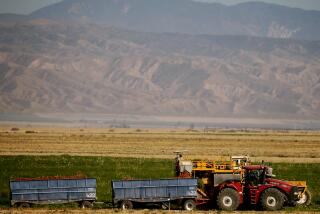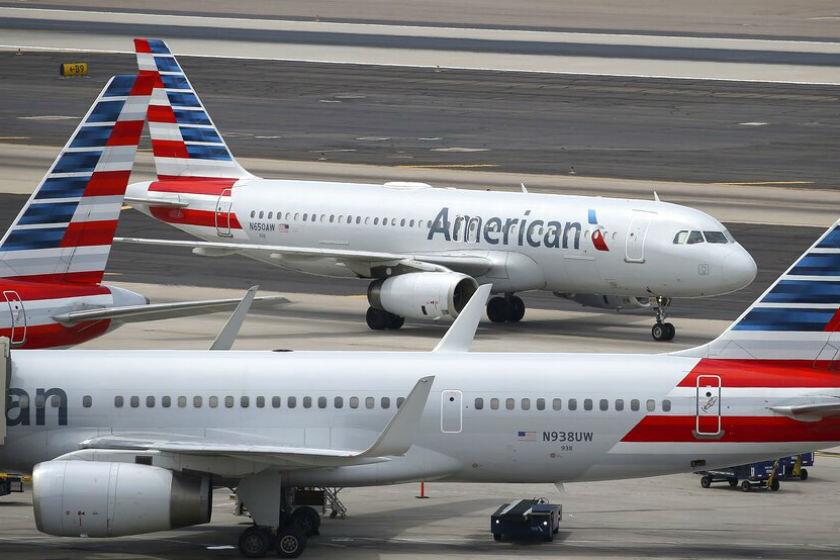Amid California’s drought, a bruising battle for cheap water

Reporting from Mendota, Calif. — The signs appear about 200 miles north of Los Angeles, tacked onto old farm wagons parked along quiet two-lane roads and bustling Interstate 5.
“Congress Created Dust Bowl.” “Stop the Politicians’ Water Crisis.” “No Water No Jobs.”
They dot the Westlands Water District like angry salutations, marking the territory of California’s most formidable water warrior. Their message is clear: Politicians and environmental laws are more to blame for Westlands’ dusty brown fields than the drought that has parched California for the last three years.
In truth, neither is to blame for Westlands’ woes so much as the simple fact that the nation’s largest irrigation district is in the wrong place.
In a state where three-quarters of the water use is by agriculture, powerful farm districts such as Westlands play an outsized role in the rough-and-tumble world of water politics.
Westlands and its wealthy farmers are exercising their considerable clout to maintain a flow of cheap water from the north despite a harsh truth. In all of California, there may be no worse place to practice the kind of industrial-scale irrigated agriculture that Westlands is famous for than the badly drained, salt-laden lands that make up roughly half the district.
Westlands has persevered for decades by battling other farmers for supplies, repeatedly suing the U.S. government and spending millions of dollars trying to roll back environmental restrictions on water deliveries — all while planting lucrative nut crops that can’t survive a season without water.
Now it is a driving force behind the most ambitious water project proposed in California in decades, the $25-billion plan to send Sacramento River supplies south to Westlands and elsewhere through two giant water tunnels burrowed under the Sacramento-San Joaquin Delta.
The water would help Westlands for a time. But the expensive tunnels would merely delay the inevitable: The more Westlands is irrigated, the more its land will be ruined.
::
The district is roughly twice the size of Los Angeles, stretching like a crooked finger for some 70 miles along the San Joaquin Valley’s sun-blasted west side.
Carved out of a region so parched it was long considered uninhabitable desert, Westlands was formed in 1952 by a group of landowners desperate for new water supplies.
They were pumping so much groundwater to irrigate crops that west-side fields were sinking like a partially baked cake. Well drillers were burrowing down more than 2,000 feet to reach steady flows. The cost of the deepest wells had hit $75,000.
The politically connected growers decided their salvation would be to get Congress to extend the Central Valley Project, the huge federal irrigation system that serves California, to the west side. President Dwight Eisenhower signed authorizing legislation for the expansion in 1960, and major deliveries from the delta, more than 150 miles to the north, started spilling into district canals eight years later.
A public agency governed by landowners within its borders, Westlands has an annual budget of more than $100 million and 111 employees. It contracts with the U.S. Bureau of Reclamation for taxpayer-subsidized irrigation supplies, which it sells to growers.
The sheer size of that contract reflects agriculture’s hold on California water supplies. The 600,000-acre, thinly populated irrigation district is entitled to more than 1.1-million acre feet of water annually — or roughly twice what the nearly 4 million residents of Los Angeles use in a year.
A half-century ago, boosters predicted that thousands of small family farms would blossom with the arrival of federal water. That vision never materialized. The few scruffy little towns within Westlands’ borders struggle with chronically high unemployment and poverty.
Large tracts were broken up to meet federal acreage limits on the delivery of taxpayer-subsidized water, but the cropland was often spread among extended family members and their trusts. Though Westlands at various times has said it serves 600 or 700 farms, University of California researchers in 2011 found that there were 350 farm networks “grouped by common ownership.”
Growers include some of the powerhouses of California agribusiness. Harris Farms Inc., Woolf Enterprises, Tanimura & Antle and other operations have made the district a highly efficient food factory that produces more than $1 billion of crops a year.
Even in this year of withering drought, the almond and pistachio trees and fields of melons, tomatoes and onions go on and on, broken only by an occasional cluster of farm buildings. With an unprecedented zero allocation of federal water, growers kept two-thirds of Westlands green by pumping groundwater and buying supplies from other districts.
In the complicated world of federal water deliveries, the west side of the San Joaquin Valley is among the first in line for cuts, whether due to drought or fish and wildlife protections that restrict deliveries from the Sacramento-San Joaquin Delta. Since 1993, Westlands has gotten its full water allotment only three times.
“They’re taking our water … in the name of helping fish. It hasn’t worked,” Westlands Chief Deputy General Manager Jason Peltier lamented last year at a Los Angeles public forum.
Growers served by Westlands boast that they have adjusted to shrinking supplies by adopting highly efficient irrigation practices. But they are also planting more profitable, permanent crops, leaving farms increasingly vulnerable to water shortages. District records show that the amount of almond and pistachio acreage has jumped sevenfold in the last two decades.
“It’s the lemmings rushing over the cliff,” said Tom Zuckerman, an attorney, delta landowner and veteran of state water politics. “They’re painting themselves into an increasingly small corner.”
Westlands’ strength comes via its political savvy. Peltier, who helped shape the Department of the Interior’s water policy under President George W. Bush, is one of several former federal officials who fill out Westlands’ well-paid management.
The district’s general counsel, Craig Manson, served as an assistant U.S. Interior secretary under Bush. Before going to work for Westlands, Deputy General Manager Sue Ramos was an assistant regional director for the Reclamation Bureau.
Their boss, General Manager Tom Birmingham, who helped forge Westlands’ aggressive reputation, declined to be interviewed for this article. In 2012, he was paid nearly $367,000, according to the state controller’s office.
A few years ago Birmingham and former board president Jean Sagouspe stormed out of a Washington meeting with high-ranking U.S. Interior and state officials after complaining about the work of federal biologists who were critiquing the delta tunnel proposal. One person in attendance likened the incident to Nikita Khrushchev’s shoe-thumping during a Cold War debate at the United Nations.
Last year, Westlands grower Mark Borba was forced to resign as chairman of a San Joaquin Valley hospital system after the Fresno Bee newspaper published an email exchange with Birmingham in which Borba referred to President Obama as “Blackie” and harangued Sen. Dianne Feinstein (D-Calif.) and the Obama administration for not doing more to increase water deliveries.
Westlands’ powerplays have periodically angered Feinstein, but she usually lends Birmingham and the board a sympathetic ear. In the email string, Birmingham assured Borba “that I have been working very closely with Senator Feinstein’s office.... Senator Feinstein and her staff have been pushing Interior and Reclamation behind the scenes.” This year Feinstein has been negotiating federal drought legislation that would, among other things, make it easier for Westlands to ship water through the delta that it has purchased from other districts.
In what critics complain is the latest example of the district’s political influence, the Reclamation Bureau is proposing to let Westlands off the hook for $360 million it still owes U.S. taxpayers for construction of its portion of the Central Valley Project. The move would be part of a deal to resolve a lingering legal fight over the broad swath of the district that is badly drained and laced with salts.
::
The dry bottom of Panoche Creek crunched beneath Walt Swain’s feet. Crusted in white sodium sulfate, the creek bed resembled a giant ribbon of salt cod strung across the rumpled hills that rise on the other side of I-5 from Westlands.
It has been nearly 30 years since Swain first scoured this harsh country, hunting for the origins of an environmental horror story.
In the early 1980s, grotesque deformities appeared in waterfowl that had nested in Kesterson National Wildlife Refuge ponds that were filled with wastewater from Westlands. The coots, grebes and ducks had been poisoned by toxic levels of selenium, a naturally occurring trace element harmful to wildlife but not to crops, that entered the refuge food chain from water drained from beneath Westlands’ fields.
Swain and other scientists with the U.S. Geological Survey found the ultimate source in the ancient sediments of the coast ranges.
For eons storm runoff had washed salts, selenium and another trace element, boron, into Panoche Creek , depositing them on land that spreads across Westlands’ northern half. There they built up in the soil over millennia, making Westlands California’s selenium hot spot.
Irrigation raised the groundwater table and stirred up what UC Davis plant scientist Stephen Grattan called the “monster that lurked below.”
To keep the damaging salts and boron out of the crop root zone, growers installed subterranean drains and pumped the water into a government drain that was originally intended to run all the way to the delta.
But it stopped at Kesterson for lack of money and because of concerns about discharging agricultural wastewater into the delta.
After discovery of the Kesterson deformities, the drain was closed.
Today, it is choked with dirt and matted weeds and posted with fading “No Swimming” signs. The Kesterson ponds are buried beneath 18 inches of dirt.
“It’s a whole sequence of events culminating with irrigation and drainage,” said Swain, who is now retired. “Decisions were made to use land totally unsuited for that purpose.”
Since then growers have blended the low-quality groundwater with imported supplies for irrigation. But they can’t stop the inexorable buildup of salts that will ultimately doom the cropland.
::
In the eastern half of Westlands, empty fields, growing nothing but scattered tumbleweeds, stretch for miles. To settle drainage and water rights disputes with growers, Westlands has purchased roughly 100,000 acres from farmers, taken some of the salted-up land out of production and left the rest unplanted in dry years.
Now it is planning a different kind of crop: Thousands of solar panels would sprout in the district’s southeast corner in a 24,000-acre solar park that Westlands is proposing to develop with the Anthem Group and several landowners.
“This is a solution that is inevitable and allows them to exit farming these lands that become more and more marginal year after year,” company executive Daniel Kim said.
Under the proposed settlement with the Reclamation Bureau, the government would lift limits on the size of farms eligible for subsidized water and relieve Westlands of its outstanding repayment obligation. In exchange, the government would be relieved of its obligation to provide drainage.
The district would permanently retire the 100,000 acres and assume responsibilities for drainage on the rest of the problem land. It would also agree to a cap on water deliveries that amounts to 75% of its contract amount — still far more than it has gotten in recent years.
Westlands is “never going to do the drainage,” contended Rep. George Miller (D-Martinez), who has spent much of his congressional career battling Westlands. “They’re going to put [the land] into solar or whatever they want to do. They’re just squeezing the government.”
Twitter: @boxall
More to Read
Sign up for Essential California
The most important California stories and recommendations in your inbox every morning.
You may occasionally receive promotional content from the Los Angeles Times.











